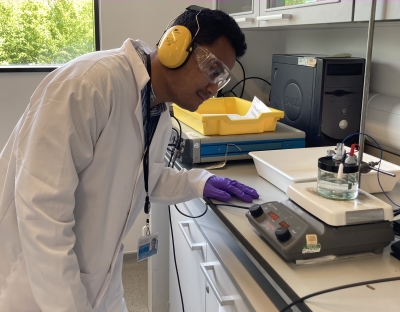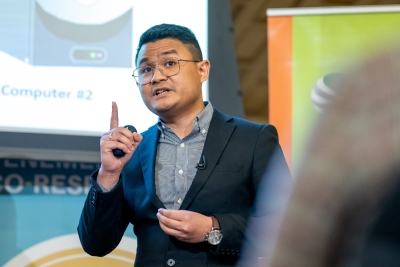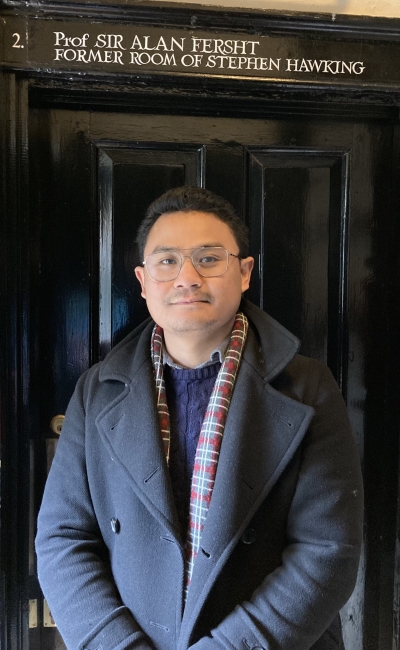Galih talks about his research, his role in the group and the future of GaN.
Download Galih's researcher profile as a PDF
How did you join the Cambridge Centre for Gallium Nitride?
I heard about the Cambridge Centre for Gallium Nitride a little while back in 2019 when I, as an undergraduate student at Nagoya University, attended the “Compound Semiconductor Week” in Nara, Japan. At the conference, I engaged with several talks from the Cambridge Centre for Gallium Nitride, including the development of III-nitride single photon emitters. Although I was really fascinated with the talks, I felt like this field was “too crowded” and chose to pursue a “quieter” field during my PhD at McGill University.
In July 2022, a few months before I defended my PhD thesis, I attended a talk by Prof Rachel Oliver on porous nitride photonics organized by IEEE Montreal. Despite having finalized where to go (I had already secured two research positions), the wonder of gallium nitride struck me (again) in the last minutes. Especially, after having a wonderful discussion with Rachel on the potential of porous nanostructures to be exploited for tuning the properties of the materials. After several follow-up discussions, Rachel mentioned that there would be a shortly available postdoctoral position and encouraged me to apply. I am very glad that I took this position to push the boundaries of porous nitrides.
What is your role in the GaN group?

Porous nitrides are III-nitride semiconductors having porous micro- and nano-structures. Initially, studies on this topic were focused on exploiting such materials to create highly reflective nitride mirrors — intended for improving the performance of nitride optoelectronic devices. Thanks to its porosity that give rise to the refractive indices.
We are currently exploring possibilities to infiltrate these pores with other materials, such as colloidal quantum dots, to create novel multifunctional composites. These quantum dots are very small (sub-10 nm in diameter) and could act as downconverters for the blue photons emitted by the nitrides. The goal of this project is to demonstrate micro-LEDs that emit across the visible spectrum; intended for augmented reality (AR) and virtual reality (VR) applications. In this project, I prepare the material by electrochemical etching, infiltrate the quantum dots by various printing techniques (i.e., aerosol jet printing, inkjet printing, and CNT-assisted flexographic printing), characterize them by various nanoscale techniques, then, hopefully, I will be able to fabricate working micro-LEDs.
Besides doing experiments, I supervise and mentor both undergraduates and graduate students, on their research projects around this topic. It is always energizing to interact with my passionate and curious students.
 What do you like best about working in the group?
What do you like best about working in the group?
The Cambridge Centre for Gallium Nitride is a world-leading research group in the field of nitride semiconductors. The group always challenges the current understanding and pushes the boundaries of the field. In the field of porous nitrides, we are exploring radical ways to infiltrate porous nitride with quantum dots using various printing technologies, and then, characterize them using state-of-the-art characterization techniques. These are all possible due to the collaborative culture in the group where we are encouraged to work with other group members or even with people from outside the group. It is fascinating to see myself being a member of these amazing people with big dreams to change the world with our science!
Where do you see nitrides in future?
Although gallium nitride has changed the way we live as a society through high-efficient LED lighting and revolutionizing the world (for the second time) with high-efficient power devices, there is still a lot more potential for gallium nitride that has not been fully unlocked.
For me, porous nitrides are a very attractive development of gallium nitride with a lot of potential applications: distributed Bragg reflectors, porous sensors, and hybrid materials. These applications are very attractive for the development of micro-LEDs which will be the main component for AR/VR applications in the (near) future. Cambridge Centre for Gallium Nitride is leading this effort, and I am very excited to be a part of this endeavour.




